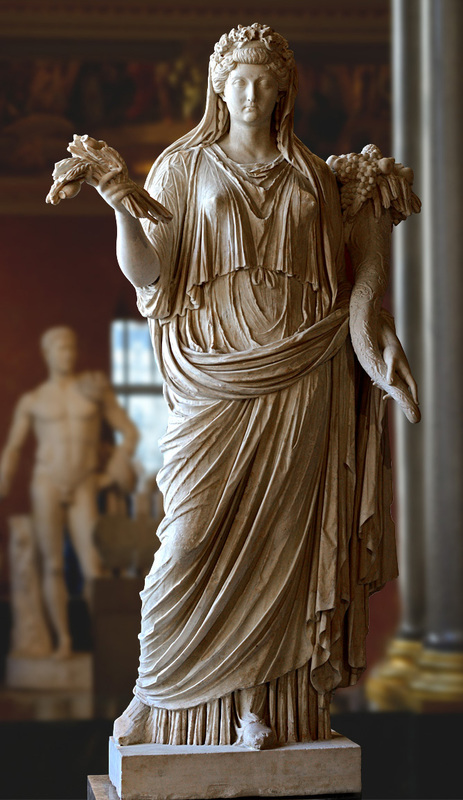Livia as Ceres
Title
Livia as Ceres
Date
post-AD 14, Julio-Claudian
Artist or Workshop
Unknown
Height of the work
32 cm
Provenience
Rome, Italy
Current Location
The Louvre, Paris, France
Sitter Biography
This is a portrait of Livia Drusilla Augusta, the wife of Octavian Augustus and mother of Tiberius. She was a member of Roman nobility. Her marriage to Octavian Augustus was about ten years before he became emperor and was actually her second marriage. Her first marriage was to Tiberius Claudius Nero making her a part of the Claudian family and it is with him that she had Tiberius. Tiberius would later become an emperor of Rome. Livia had a significant role during Tiberius’ reign and is depicted on coins.
Description and Significance
Description:
This is a full body statue of a woman, Livia. She is wearing a traditional ancient Roman stola, long pleated robe, and draped in a palla, square fabric around the body. The fabric is elaborately carved with many folds and hugs the figure of the Livia. She also has an elaborate hairstyle braided back to a bun or nodus. There is a bump in the hair on her forehead. She is wearing a crown of flowers and headband with fabric draped over her head as well. In her left hand she is holding a cornucopia filled with fruits and vegetables and in her right hand has grains, both are very clear references to Ceres. Livia has a beautiful face that is symmetrical and has smooth idealized skin. The eyes are large almond shapes and the mouth is very small. The face is very clearly Livia’s face, as can be determined by looking at other portraits of her, even though she is in the guise of Ceres.
Significance:
In this statue Livia is being portrayed in the guise of Ceres. Ceres is the goddess of agriculture and the harvest in the Roman pantheon. This being a guise portraits means that it is Livia’s face with attributes, and possibly the rest of the body, that are common for a particular individual, often a god or goddess. By doing this the aspects of the god or goddess is then assumed by the sitter of the portrait. The connection to Ceres is being made in order to emphasize Livia’s role as the mother of Tiberius, a Roman emperor. It is also highlighting nature and fertility through the plants and cornucopia. Her dress of the stola and palla are also referencing her motherhood as they are both common in a traditional Roman marriage. The emphasis on her fertility show how she does not just provide for her family but for the whole Roman empire through her marriage to Octavian and being the mother of Tiberius.
This is a full body statue of a woman, Livia. She is wearing a traditional ancient Roman stola, long pleated robe, and draped in a palla, square fabric around the body. The fabric is elaborately carved with many folds and hugs the figure of the Livia. She also has an elaborate hairstyle braided back to a bun or nodus. There is a bump in the hair on her forehead. She is wearing a crown of flowers and headband with fabric draped over her head as well. In her left hand she is holding a cornucopia filled with fruits and vegetables and in her right hand has grains, both are very clear references to Ceres. Livia has a beautiful face that is symmetrical and has smooth idealized skin. The eyes are large almond shapes and the mouth is very small. The face is very clearly Livia’s face, as can be determined by looking at other portraits of her, even though she is in the guise of Ceres.
Significance:
In this statue Livia is being portrayed in the guise of Ceres. Ceres is the goddess of agriculture and the harvest in the Roman pantheon. This being a guise portraits means that it is Livia’s face with attributes, and possibly the rest of the body, that are common for a particular individual, often a god or goddess. By doing this the aspects of the god or goddess is then assumed by the sitter of the portrait. The connection to Ceres is being made in order to emphasize Livia’s role as the mother of Tiberius, a Roman emperor. It is also highlighting nature and fertility through the plants and cornucopia. Her dress of the stola and palla are also referencing her motherhood as they are both common in a traditional Roman marriage. The emphasis on her fertility show how she does not just provide for her family but for the whole Roman empire through her marriage to Octavian and being the mother of Tiberius.
References
Giroire, Cecile and Daniel Roger. Roman Art from the Louvre. American Federation of Arts, 2007.
Kleiner, D. E. E. 1994. Roman Sculpture, New Haven. pp. 75-78.
Marie-Benedicte, Astier. “Livia.” The Louvre Museum. Web.
Kleiner, D. E. E. 1994. Roman Sculpture, New Haven. pp. 75-78.
Marie-Benedicte, Astier. “Livia.” The Louvre Museum. Web.
Contributor
Nina Cardillo
Citation
Unknown, “Livia as Ceres,” Digital Portrait "Basket" - ARTH488A - "Ancient Mediterranean Portraiture", accessed May 20, 2024, https://classicalchopped2.artinterp.org/omeka/items/show/38.
Item Relations
This item has no relations.

